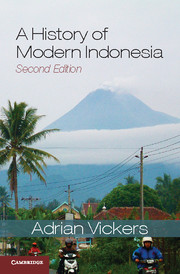1714 results in South-East Asian government, politics and policy
Chapter 5 - Living in the atomic age
-
- Book:
- A History of Modern Indonesia
- Published online:
- 05 February 2013
- Print publication:
- 25 March 2013, pp 117-145
-
- Chapter
- Export citation
Biographies of key figures
-
- Book:
- A History of Modern Indonesia
- Published online:
- 05 February 2013
- Print publication:
- 25 March 2013, pp 237-244
-
- Chapter
- Export citation
Index
-
- Book:
- A History of Modern Indonesia
- Published online:
- 05 February 2013
- Print publication:
- 25 March 2013, pp 297-306
-
- Chapter
- Export citation
Chapter 2 - Cultures of the countryside
-
- Book:
- A History of Modern Indonesia
- Published online:
- 05 February 2013
- Print publication:
- 25 March 2013, pp 34-59
-
- Chapter
- Export citation

A History of Modern Indonesia
-
- Published online:
- 05 February 2013
- Print publication:
- 25 March 2013

Understanding Australia's Neighbours
- An Introduction to East and Southeast Asia
-
- Published online:
- 05 June 2012
- Print publication:
- 26 September 2011

No Other Way Out
- States and Revolutionary Movements, 1945–1991
-
- Published online:
- 05 June 2012
- Print publication:
- 04 June 2001

South Korea since 1980
-
- Published online:
- 05 June 2012
- Print publication:
- 28 June 2010

The Politics of Uneven Development
- Thailand's Economic Growth in Comparative Perspective
-
- Published online:
- 05 June 2012
- Print publication:
- 09 February 2009

The Politics of Oil in Indonesia
- Foreign Company-Host Government Relations
-
- Published online:
- 05 November 2011
- Print publication:
- 03 July 1986
10 - Globalisation and East and Southeast Asia
-
- Book:
- Understanding Australia's Neighbours
- Published online:
- 05 June 2012
- Print publication:
- 26 September 2011, pp 179-198
-
- Chapter
- Export citation
Index
-
- Book:
- Understanding Australia's Neighbours
- Published online:
- 05 June 2012
- Print publication:
- 26 September 2011, pp 265-275
-
- Chapter
- Export citation
4 - Colonialism in East and Southeast Asia
-
- Book:
- Understanding Australia's Neighbours
- Published online:
- 05 June 2012
- Print publication:
- 26 September 2011, pp 61-80
-
- Chapter
- Export citation
Introduction
-
- Book:
- Understanding Australia's Neighbours
- Published online:
- 05 June 2012
- Print publication:
- 26 September 2011, pp 1-4
-
- Chapter
- Export citation
2 - Tradition and modernity in East and Southeast Asia
-
- Book:
- Understanding Australia's Neighbours
- Published online:
- 05 June 2012
- Print publication:
- 26 September 2011, pp 23-41
-
- Chapter
- Export citation
1 - The idea of ‘Asia’
-
- Book:
- Understanding Australia's Neighbours
- Published online:
- 05 June 2012
- Print publication:
- 26 September 2011, pp 5-22
-
- Chapter
- Export citation
Frontmatter
-
- Book:
- Understanding Australia's Neighbours
- Published online:
- 05 June 2012
- Print publication:
- 26 September 2011, pp i-iv
-
- Chapter
- Export citation
11 - China–Japan relations and US power in the twenty-first century
-
- Book:
- Understanding Australia's Neighbours
- Published online:
- 05 June 2012
- Print publication:
- 26 September 2011, pp 199-219
-
- Chapter
- Export citation
3 - Tradition and modernity in East and Southeast Asia
-
- Book:
- Understanding Australia's Neighbours
- Published online:
- 05 June 2012
- Print publication:
- 26 September 2011, pp 42-60
-
- Chapter
- Export citation
12 - Australia in Asia, ‘Asia’ in Australia
-
- Book:
- Understanding Australia's Neighbours
- Published online:
- 05 June 2012
- Print publication:
- 26 September 2011, pp 220-238
-
- Chapter
- Export citation

